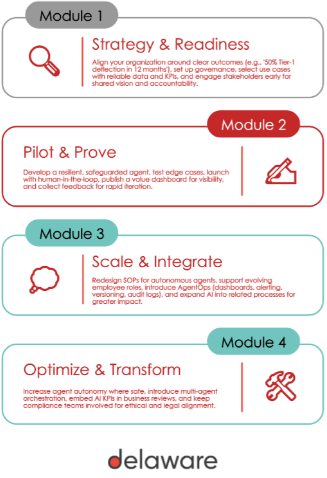Setting the stage for scalable agentic AI success
To ensure this momentum is sustained, leaders should set an ambitious yet practical roadmap for expansion. Begin by identifying the next set of high-impact use cases, those where agentic AI can deliver outsized returns or address persistent operational pain points. Prioritize initiatives where measurable business outcomes can be demonstrated quickly, creating proof points that build organizational confidence.
Establish cross-functional "AI value squads" that pair domain experts with technical leads. These teams can rapidly prototype, test, and refine agent-driven workflows, embedding feedback loops that surface insights and surface challenges early. Don't wait for perfection, move forward with agile pilots, using transparent metrics to decide when to scale or pivot.
Double down on change management: invest in targeted training that empowers business users to interact with, supervise, and even improve agent behaviors. Celebrate quick wins and lessons learned, making successes visible across the organization. Use storytelling and real-world data to demystify AI, reinforcing the message that agentic systems are partners, not replacements.
Finally, revisit your governance structures as adoption grows. Regularly update risk assessments and compliance checklists to reflect new capabilities and workflows. As agents become more autonomous, expand your monitoring to include not just technical KPIs but also user satisfaction and unexpected downstream effects.
By moving deliberately, balancing speed with stewardship, you create a culture where AI is not a bolt-on but an integrated force for progress.



.png)

/GenAi-banner-3200x500-(1).webp?mode=autocrop&w=320&h=240&attachmenthistoryguid=43b8c09a-c9de-4645-b198-a326e7c38da9&v=&focusX=2765&focusY=243&c=d764f212f96b86ae1ec874be4a2af20e7788059d3c7979d437633cf518550c9f)
/portrait-person-ai-robot-(1).webp?mode=autocrop&w=320&h=240&attachmenthistoryguid=93cbd77e-73fa-4696-b595-6961260da3f1&v=&focusX=1182&focusY=2321&c=5c4b25b68b3866cf065643cd765c5d143fb2b2cac8e5e289f94a34f5d3d44ce2)